
Journal on Multimodal User Interfaces
Scope & Guideline
Driving Collaboration in Multimodal Interface Research
Introduction
Aims and Scopes
- Multimodal Interaction Design:
The journal prioritizes research that explores the design and evaluation of user interfaces that utilize multiple sensory modalities, including visual, auditory, and tactile inputs, to improve user engagement and effectiveness. - User-Centered Approaches:
A core aim of the journal is to promote user-centered methodologies in the development of interactive systems, ensuring that the needs and experiences of users are central to design and evaluation processes. - Technological Innovations:
The journal showcases advancements in technology that facilitate multimodal interaction, such as augmented reality, virtual reality, and assistive technologies that cater to diverse user needs. - Applications Across Domains:
Research published in the journal spans various application areas, including transportation, education, healthcare, and robotics, highlighting the versatility and importance of multimodal interfaces. - Interdisciplinary Perspectives:
The journal encourages interdisciplinary research that combines insights from fields such as cognitive science, human-computer interaction, and engineering to foster a holistic understanding of multimodal user interfaces.
Trending and Emerging
- Augmented and Virtual Reality Applications:
There is a significant increase in research related to augmented and virtual reality applications, particularly how these technologies enhance user interaction and training in various environments, from education to industry. - Human-Robot Interaction:
Emerging themes in human-robot interaction highlight the importance of multimodal communication strategies, including the use of avatars and emotional expression to improve perceived security and user engagement. - Assistive Technologies for Diverse Users:
Research focusing on assistive technologies for users with disabilities, such as visual impairments, has gained traction, emphasizing the role of multimodal interfaces in promoting accessibility and inclusivity. - Machine Learning in Interaction Design:
The integration of machine learning techniques to analyze and enhance multimodal interactions is a growing trend, with studies exploring predictive modeling and user behavior analysis. - Sonification and Multisensory Feedback:
There is an increasing interest in the use of sonification and multisensory feedback mechanisms to enhance user experience, particularly in complex environments like healthcare and education.
Declining or Waning
- Traditional User Interface Methods:
There has been a noticeable decrease in research focused on conventional user interface methods that do not incorporate multimodal elements, as the field increasingly embraces more interactive and immersive technologies. - Basic Gesture Recognition:
Research centered on basic gesture recognition without the integration of multimodal feedback has waned, as the emphasis shifts towards more complex and context-aware interaction techniques. - Single-Modal Interaction Studies:
Studies that explore single-modal interactions, particularly those that isolate one sensory modality, have become less common, reflecting a growing recognition of the need for multimodal approaches to enhance user experience. - Static Feedback Mechanisms:
There is a decline in interest in static feedback mechanisms that do not leverage dynamic multimodal inputs, as research increasingly favors adaptive systems that respond to users' multimodal cues. - Focus on Traditional Learning Environments:
The exploration of multimodal interfaces within traditional learning environments has decreased, as there is a shift towards more innovative educational settings that leverage technology for enhanced interaction.
Similar Journals

International Journal of Digital Multimedia Broadcasting
Advancing the Future of Multimedia BroadcastingThe International Journal of Digital Multimedia Broadcasting is a leading scholarly platform dedicated to the interdisciplinary exploration of digital multimedia broadcasting, published by HINDAWI LTD. With an ISSN of 1687-7578 and an E-ISSN of 1687-7586, this Open Access journal has made significant strides since its inception in 2008, ensuring wide accessibility and dissemination of research. Based in the United States, at Adam House, 3rd Flr, 1 Fitzroy Sq, London W1T 5HF, England, the journal covers a range of topics relevant to Communication, Electrical and Electronic Engineering, and Media Technology, boasting impressive Scopus rankings that highlight its influence in these fields. As part of the Q3 category in Communication and Electrical Engineering, and Q2 in Media Technology for 2023, the journal serves a vital role in fostering the understanding of technological advancements and their applications in multimedia broadcasting. Researchers, professionals, and students are encouraged to contribute to and benefit from the journal's rich repository of knowledge, paving the way for innovative developments in this dynamic industry.

Frontiers in Computer Science
Driving the future of technology through scholarly exploration.Frontiers in Computer Science is a premier open-access journal published by Frontiers Media SA that has rapidly established itself as a prominent platform for scholarly research in the diverse and evolving field of computer science. With a notable impact factor reflecting its high citation rates, this journal aims to disseminate innovative findings and groundbreaking studies across multiple subdisciplines, including Computer Science Applications, Computer Vision and Pattern Recognition, and Human-Computer Interaction. Since its inception in 2019, and with a consistent trajectory from 2019 to 2024, it has garnered accolades, achieving Q2 ranking in several categories and an impressive Q1 in miscellaneous areas of computer science. Researchers, professionals, and students alike are encouraged to contribute to this dynamic journal that serves as a vital resource for advancing knowledge and fostering collaborative dialogue in the global computer science community. Frontiers in Computer Science is committed to providing open access to research, promoting unrestricted sharing of ideas and fostering innovation at the intersection of technology and society.
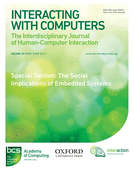
INTERACTING WITH COMPUTERS
Pioneering Research at the Forefront of InteractionINTERACTING WITH COMPUTERS is a renowned journal published by Oxford University Press, focusing on the interdisciplinary field of Human-Computer Interaction, as well as aspects of Library and Information Sciences and Software. With a rich history of publication since 1989, this journal has established itself as a significant platform for scholars to disseminate cutting-edge research and innovative methodologies that enhance our understanding of how humans engage with technology. Despite being classified in the Q3 and Q2 quartiles across various categories, its 2023 Scopus rankings highlight its relevance, positioning it within the 69th percentile for Library and Information Sciences. This makes it an essential resource for researchers, professionals, and students looking to stay informed about the latest advancements and discussions in this rapidly evolving domain. Though not currently open access, INTERACTING WITH COMPUTERS offers substantial insights that are crucial for driving forward the conversation in Human-Computer Interaction, ensuring its relevance in both academic and applied contexts.
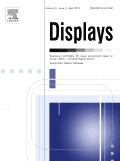
DISPLAYS
Driving Innovation in the World of DisplaysDISPLAYS is a prestigious journal published by Elsevier that focuses on the dynamic intersection of Electrical and Electronic Engineering, Hardware and Architecture, and Human-Computer Interaction. Since its inception in 1979, the journal has made significant contributions to advancing the field, currently holding a notable impact factor and ranking within the Q2 category across multiple disciplines, including Electrical and Electronic Engineering, Hardware and Architecture, and Human-Computer Interaction. With its broad scope, DISPLAYS is dedicated to publishing high-quality research that inspires innovation in display technology and its applications. Researchers and professionals benefit from access to cutting-edge findings in the realm of display systems, which are integral to the evolving landscape of digital interaction. Operating without an open access option, the journal ensures rigorous peer review, maintaining the highest standards of academic integrity and research quality. Positioned in the heart of the Netherlands, DISPLAYS continues to play a critical role in shaping future advancements, making it an essential read for anyone committed to these vital fields of study.
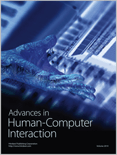
Advances in Human-Computer Interaction
Unlocking the potential of human and computer synergy.Advances in Human-Computer Interaction is a premier peer-reviewed journal published by HINDAWI LTD, dedicated to the exploration of cutting-edge research and innovation in the field of Human-Computer Interaction (HCI). With an ISSN of 1687-5893 and an E-ISSN of 1687-5907, this Open Access journal has been contributing to the scientific community since 2008, offering unrestricted access to critical findings and advancements. Based in Egypt with an address at ADAM HOUSE, 3RD FLR, 1 FITZROY SQ, LONDON W1T 5HF, ENGLAND, it occupies a notable position in the academic landscape, reflected in its 2023 Scopus ranking of Rank #57/145 and a 61st percentile in the Human-Computer Interaction category. As a Q3 journal, it plays a crucial role in disseminating research that bridges the gap between humans and technology, providing valuable insights for researchers, professionals, and students pursuing expertise in this dynamic field. The journal’s converged years from 2010 to 2024 signify its ongoing commitment to advancing knowledge and fostering collaboration among HCI experts worldwide.
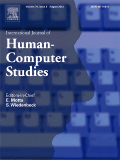
INTERNATIONAL JOURNAL OF HUMAN-COMPUTER STUDIES
Illuminating the Future of Human-Computer StudiesINTERNATIONAL JOURNAL OF HUMAN-COMPUTER STUDIES, published by Academic Press Ltd - Elsevier Science Ltd, stands at the forefront of research dedicated to the dynamic interplay between humans and technology. With a remarkable impact factor reflective of its rigorous academic standards and its prestigious ranking in the Q1 category across vital disciplines such as Education, Engineering, Human Factors and Ergonomics, and Human-Computer Interaction, this journal serves as an essential resource for researchers, professionals, and students alike. Spanning from 1994 to 2024, it showcases pioneering studies that contribute significantly to the understanding of cognitive processes, usability, and the evolving role of technology in society. Despite the absence of Open Access options, access to this journal is facilitated through institutional subscriptions, ensuring that critical findings and advancements are readily available to a global audience. By continuing to publish high-quality research, the INTERNATIONAL JOURNAL OF HUMAN-COMPUTER STUDIES plays a crucial role in advancing the field, fostering innovation, and guiding future research directions.

VIRTUAL REALITY
Advancing Knowledge in Virtual EnvironmentsVIRTUAL REALITY is a prestigious journal published by SPRINGER LONDON LTD that has been at the forefront of the field since its inception in 1995. This journal, with an ISSN of 1359-4338 and E-ISSN 1434-9957, serves as an indispensable resource for researchers, professionals, and students interested in the rapidly evolving domains of computer graphics, human-computer interaction, and software development. VIRTUAL REALITY holds an impressive Q1 ranking across relevant categories, reflecting its high impact within the academic community, with specific rankings such as 11th overall in Computer Graphics and Computer-Aided Design and 31st in Human-Computer Interaction. This journal aims to publish cutting-edge research that explores theoretical advancements and practical applications related to virtual environments, contributing significantly to knowledge and innovation. With access options available through institutional subscriptions, it continues to shape the landscape of its field and inspire future research in immersive technologies.
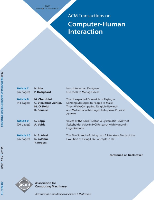
ACM Transactions on Computer-Human Interaction
Pioneering Insights into Cognitive Processes and DesignACM Transactions on Computer-Human Interaction (ISSN: 1073-0516; E-ISSN: 1557-7325) is a prestigious journal published by the Association for Computing Machinery, focusing on the dynamic and rapidly evolving field of Human-Computer Interaction (HCI). With an impressive 2023 impact factor reflecting its high-quality research output, it proudly holds a Q1 ranking in the HCI category on Scopus, positioning it among the top journals in the field. Established in 1994, the journal has been a vital resource for researchers and professionals alike, featuring innovative studies that explore the design, evaluation, and implementation of user interfaces and interactive systems. Its broad scope encompasses various aspects of HCI, including cognitive processes, user experience design, and the social implications of technology. As an essential read for anyone involved in HCI research and practice, the journal is a gateway to advancements that shape the future of human-technology interactions. The journal is accessible to readers globally, and it plays a pivotal role in disseminating knowledge that drives excellence in software design and user interface research.
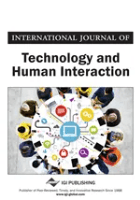
International Journal of Technology and Human Interaction
Advancing Understanding at the Intersection of Innovation and InteractionInternational Journal of Technology and Human Interaction, published by IGI Global, serves as a critical platform for the exploration of the intersection between technology and human behavior, offering an interdisciplinary lens on topics within the realms of Human-Computer Interaction and Information Systems. With an ISSN of 1548-3908 and an E-ISSN of 1548-3916, this journal has been contributing to scholarly discourse since its inception in 2005, with ongoing publication until 2024. Hosting a diverse range of research articles, case studies, and reviews, the journal aims to advance the understanding of how technology influences human experience and interaction patterns in various contexts. Although currently positioned in the Q4 quartile of both Human-Computer Interaction and Information Systems categories, the journal fosters knowledge that aspires to redefine scope and standards within the field. Its commitment to quality research is reflected in its Scopus rankings, showcasing its relevance despite its emerging status in academia. Targeting researchers, professionals, and students alike, the International Journal of Technology and Human Interaction invites contributions that address the pressing challenges and innovations at the nexus of technology and human interaction.

International Journal of Mobile Human Computer Interaction
Bridging theory and practice in mobile HCI.International Journal of Mobile Human Computer Interaction (IJMHCI) is a leading scholarly publication dedicated to advancing the field of human-computer interaction in mobile environments. Established by IGI Global, this journal has served as a vital platform for researchers and professionals since its inception in 2009. With a focus on innovative designs, user experience, and the evolving landscape of mobile technology, IJMHCI plays a critical role in bridging theoretical research and practical applications. Though currently categorized in Q4 within the Human-Computer Interaction category for 2023, its consistent publication across the years reflects a commitment to fostering insightful discussions among academia and industry practitioners alike. The journal is indexed in Scopus, ranking #78 out of 145 in its field, highlighting its growing influence. While it does not currently offer open access options, its valuable contributions to mobile HCI research make it an essential resource for students and established researchers striving to explore the complexities of human interaction with mobile technologies.